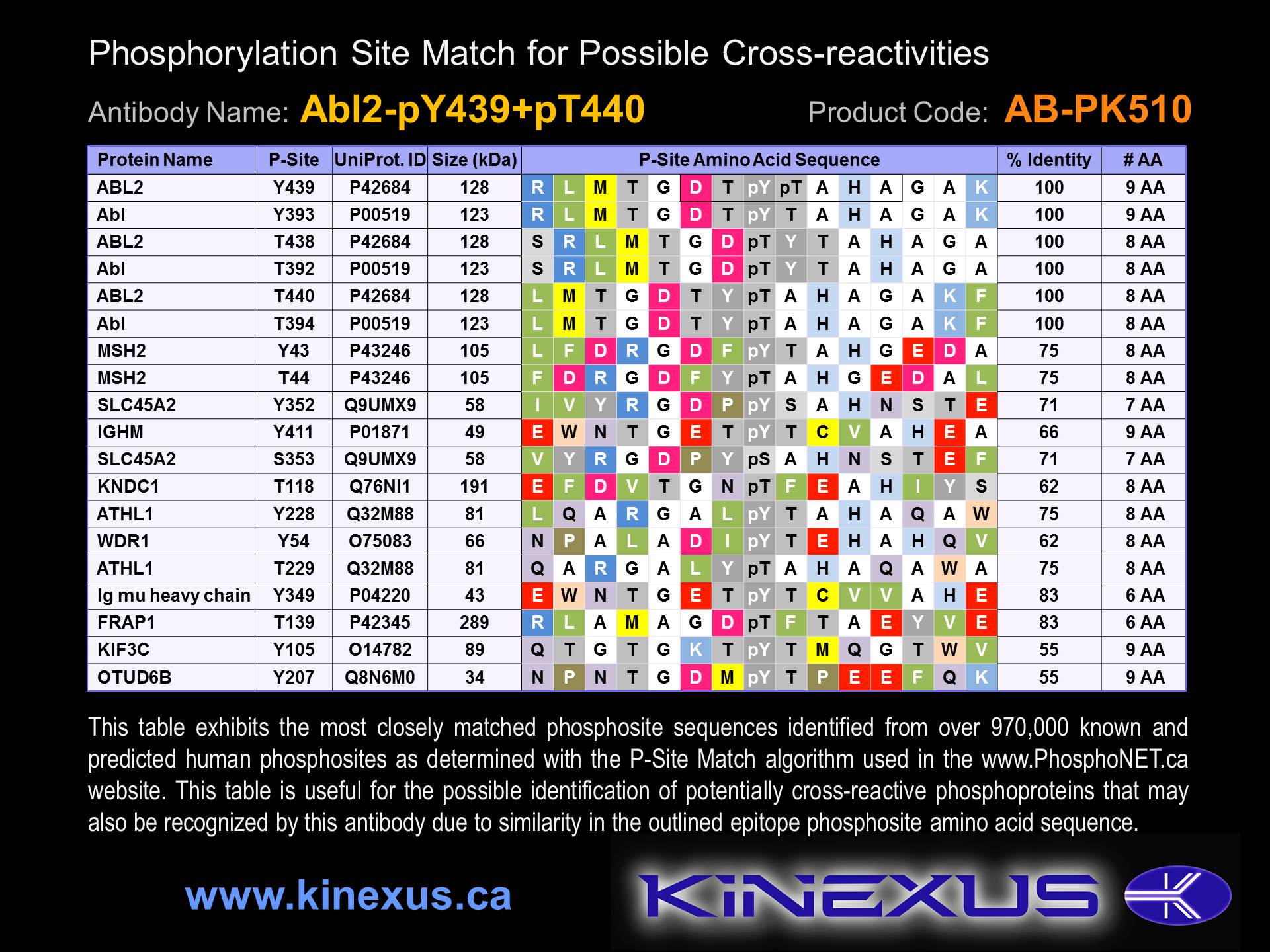Product Name: Abl2-pY439+pT440
Product Number: AB-PK510
| Size: | 25 µg | Price: | 89.00 | |
| $US |
Target Full Name: Abelson murine leukemia viral oncogene homologue 2
Target Alias: Abelson-related gene; ABLL; ARG; Kinase Arg; Tyrosine kinase ARG; v-Abl Abelson murine leukemia viral oncogene 2; v-Abl Abelson murine leukemia viral oncogene homologue 2; hCG_23565; FLJ22224; FLJ31718; FLJ41441; RP11-177A2_3; ENSG00000143322; D1MPS6
Product Type Specific: Protein kinase phosphosite-specific antibody
Antibody Code: PK510
Antibody Target Type: Phosphosite-specific
Antibody Phosphosite: Y439+T440
Protein UniProt: P42684
Protein SigNET: P42684
Antibody Type: Polyclonal
Target Alias: Abelson-related gene; ABLL; ARG; Kinase Arg; Tyrosine kinase ARG; v-Abl Abelson murine leukemia viral oncogene 2; v-Abl Abelson murine leukemia viral oncogene homologue 2; hCG_23565; FLJ22224; FLJ31718; FLJ41441; RP11-177A2_3; ENSG00000143322; D1MPS6
Product Type Specific: Protein kinase phosphosite-specific antibody
Antibody Code: PK510
Antibody Target Type: Phosphosite-specific
Antibody Phosphosite: Y439+T440
Protein UniProt: P42684
Protein SigNET: P42684
Antibody Type: Polyclonal
Antibody Host Species: Rabbit
Antibody Immunogen Source: Human Abl2 (Arg) sequence peptide Cat. No.: PE-04AFH95
Antibody Immunogen Sequence: DT(pY)(pT)AHA(bA)C
Antibody Immunogen Description: Corresponds to amino acid residues D437 to A443; In the protein kinase catalytic domain activation T loop region between subdomains VII and VIII.
Antibody Immunogen Source: Human Abl2 (Arg) sequence peptide Cat. No.: PE-04AFH95
Antibody Immunogen Sequence: DT(pY)(pT)AHA(bA)C
Antibody Immunogen Description: Corresponds to amino acid residues D437 to A443; In the protein kinase catalytic domain activation T loop region between subdomains VII and VIII.
Production Method: The immunizing peptide was produced by solid phase synthesis on a multipep peptide synthesizer and purified by reverse-phase hplc chromatography. Purity was assessed by analytical hplc and the amino acid sequence confirmed by mass spectrometry analysis. This peptide was coupled to KLH prior to immunization into rabbits. New Zealand White rabbits were subcutaneously injected with KLH-coupled immunizing peptide every 4 weeks for 4 months. The sera from these animals was applied onto an agarose column to which the immunogen peptide was thio-linked. Antibody was eluted from the column with 0.1 M glycine, pH 2.5. Subsequently, the antibody solution was neutralized to pH 7.0 with saturated Tris.This antibody was also subject to negative purification over phosphotyrosine-agarose.
Antibody Modification: Unconjugated. Contact KInexus if you are interest in having the antibody biotinylated or coupled with fluorescent dyes.
Antibody Modification: Unconjugated. Contact KInexus if you are interest in having the antibody biotinylated or coupled with fluorescent dyes.
Antibody Concentration: 1 mg/ml
Storage Buffer: Phosphate buffered saline pH 7.4, 0.05% Thimerasol
Storage Conditions: For long term storage, keep frozen at -40°C or lower. Stock solution can be kept at +4°C for more than 3 months. Avoid repeated freeze-thaw cycles.
Product Use: Western blotting | Antibody microarray
Antibody Dilution Recommended: 2 µg/ml for immunoblotting
Antibody Potency: Medium immunoreactivity with immunogen peptide on dot blots. Very strong immunoreactivity with recombinant human Abl2 on protein dot blots.
Antibody Species Reactivity: Human
Storage Buffer: Phosphate buffered saline pH 7.4, 0.05% Thimerasol
Storage Conditions: For long term storage, keep frozen at -40°C or lower. Stock solution can be kept at +4°C for more than 3 months. Avoid repeated freeze-thaw cycles.
Product Use: Western blotting | Antibody microarray
Antibody Dilution Recommended: 2 µg/ml for immunoblotting
Antibody Potency: Medium immunoreactivity with immunogen peptide on dot blots. Very strong immunoreactivity with recombinant human Abl2 on protein dot blots.
Antibody Species Reactivity: Human
Antibody Positive Control: The observed molecular mass of the processed target protein on SDS-PAGE gels is reported to be around 130-140 kDa.
Antibody Specificity: High
Antibody Cross Reactivity: Strong immunoreactivity on protein dot blots with recombinant human Abl1, which features identical phosphorylation sites. ~27 and 85 kDa cross-reactive proteins were detected in FBS-stimulated Jurkat cells.
Related Product 1: Abl2-pY439+pT440 blocking peptide
Related Product 2: Abl2-1 pan-specific antibody (Cat. No.: AB-NK238-1)
Related Product 3: Abl2-pY439 phosphosite-specific antibody (Cat. No.: AB-PK509)
Related Product 4: AblSubtide - Abl1 protein kinase substrate peptide
Antibody Specificity: High
Antibody Cross Reactivity: Strong immunoreactivity on protein dot blots with recombinant human Abl1, which features identical phosphorylation sites. ~27 and 85 kDa cross-reactive proteins were detected in FBS-stimulated Jurkat cells.
Related Product 1: Abl2-pY439+pT440 blocking peptide
Related Product 2: Abl2-1 pan-specific antibody (Cat. No.: AB-NK238-1)
Related Product 3: Abl2-pY439 phosphosite-specific antibody (Cat. No.: AB-PK509)
Related Product 4: AblSubtide - Abl1 protein kinase substrate peptide
Scientific Background: Arg (Abl2) is a protein-tyrosine kinase of the TK group and Abl family. It features SH3 and SH2 domains, a protein- tyrosine kinase domain, and a nuclear localization domain. It shares many functions with Abl1, which includes cytoskeleton remodelling through phosphorylation of enzymes responsible for cytoskeleton rearrangements for signalling, adhesion, and movement as well as microtuble subunits, TUBA1 and TUBB. It also contains F-actin binding region to bundle and regulate actin cytoskeletal structure. It possesses autocatalytic activity and the ability to phosphorylate its inhibitor ABI1 to regulate itself. Arg gene expression is found in both normal and tumour cells, it is often found as a fusion gene with ETV6 in acute non lymphocytic leukemias. However, the broad distribution of point mutations seen in various cancers, including about a third within the kinase catalytic domain, indicate that these mutations are likely to be silent or result in loss of function. Arg has also been reported to promote breast tumour cell invasion and dissemination, but attenuates the growth of breast tumours. This indicates that wild-type Arg may as a tumour suppressor protein. Phosphorylation of Tyr-261 reduces ubiquitination and protein degradation. Arg is activated by autophosphorylation as well as by Src-family kinase-mediated phosphorylation. It is also activated by RIN1 binding to the SH2 and SH3 domains.
© Kinexus Bioinformatics Corporation 2017


